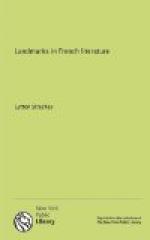One other work has come down to us from this early epoch, which presents a complete contrast, both with the rough, bold spirit of the Chansons de Geste and the literal realism of the Fabliaux. This is the ‘chante-fable’ (or mingled narrative in verse and prose) of Aucassin et Nicolete. Here all is delicacy and exquisiteness—the beauty, at once fragile and imperishable, of an enchanting work of art. The unknown author has created, in his light, clear verse and his still more graceful and poetical prose, a delicious atmosphere of delicate romance. It is ‘the tender eye-dawn of aurorean love’ that he shows us—the happy, sweet, almost childish passion of two young creatures who move, in absolute innocence and beauty, through a wondrous world of their own. The youth Aucassin, who rides into the fight dreaming of his beloved, who sees her shining among the stars in heaven—
Estoilette, je te voi,
Que la lune trait a soi;
Nicolete est avec toi,
M’amiete o le blond
poil.
(Little star, I see thee there,
That the moon draws close
to her!
Nicolette is with thee there,
My love of the yellow hair.)—
who disdains the joys of Paradise, since they exclude the joys of loving—
En paradis qu’ai-je a faire? Je n’i quier entrer, mais que j’aie Nicolete, ma tres douce amie que j’aime tant.... Mais en enfer voil jou aler. Car en enfer vont li bel clerc et li bel cevalier, qui sont mort as tournois et as rices guerres, et li bien sergant, et li franc homme.... Avec ciax voil jou aler, mais que j’aie Nicolete, ma tres douce amie, avec moi. [What have I to do in Paradise? I seek not to enter there, so that I have Nicolette,




